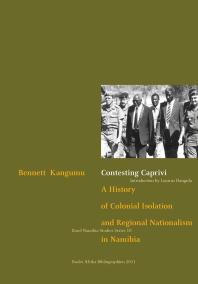(Ebook PDF) Contesting Caprivi A History of Colonial Isolation and Regional Nationalism in Namibia 1st Edition Bennett Kangumu ISBN 9783905758467 3905758466 full chapters
$50.00 Original price was: $50.00.$35.00Current price is: $35.00.
Contesting Caprivi A History of Colonial Isolation and Regional Nationalism in Namibia 1st Edition Bennett Kangumu Digital Instant Download
Author(s): Bennett Kangumu
ISBN(s): 9783905758467, 3905758466
Edition: 1
File Details: PDF, 19.98 MB
Year: 2011
Language: english
(Ebook PDF) Contesting Caprivi A History of Colonial Isolation and Regional Nationalism in Namibia 1st Edition Bennett Kangumu -Ebook PDF Instant Download/Delivery:9783905758467, 3905758466
Instant download Full Chapter of Contesting Caprivi A History of Colonial Isolation and Regional Nationalism in Namibia 1st Edition after payment

Product details:
ISBN 10:3905758466
ISBN 13:978390575846
Author: Bennett Kangumu
Caprivi, the remote and narrow Namibian strip of land encapsulated by neighbouring Angola, Zambia and Botswana, has a contested colonial and postcolonial history. Bennett Kangumu traces the politics of its people in this complex borderlands since the late 19th century. Neglected by German and South African colonial administrations, its inhabitants were often pushed towards neighbouring territories though not being an integral part of them. At the same time, South African apartheid and homeland politics emphasised the ethnization of local identities. Becoming a strategic location in the ensuing liberation wars of the late 20th century, its history is often one of conquest and resistance, plunder, betrayal and rivalry. Kangumu shows how the inhabitants of Caprivi responded in various ways, notably in the form of regional nationalism when the Caprivi African National Union (CANU) was formed in the early 1960s. The Union�s merger with the dominant Namibian liberation movement, SWAPO, was a claim to end seperation and isolation, which, however, flarred up again in post-colonial Namibia.
Table of Contents:
- 1 Introduction
- Population
- Ethnic Terminology
- Sources and Methodology
- Limitations of the Study
- Literature Review
- 2 Pre-Colonial Caprivi: Conquest, Betrayel and Rivalry
- Subiya-Lozi Relations
- Subiya-Makololo Interaction
- Subiya Defiance after the Lozi Restoration
- Other Groups in Pre-colonial Caprivi
- Summary
- 3 Colonial Administrative Identity I: From 1890 to World War II
- Informal Colonialism: Missionaries, Traders, and their Interaction in Caprivi
- The Creation of the Caprivi Identities
- Germany’s Riparian State on the Zambezi
- Creating the Caprivi Identities
- Administering the Caprivi during the German Colonial Rule
- A Sphere of Influence, 1890-1909
- Ma-Dostela in Der Caprivi Zipfel, 1909-1914
- A Transferable Identity: The Caprivi 1914-1939
- Military Rule, 1915-1921
- Under the Bechuanaland Administration, 1921-1929
- Appended to SWAA: The Caprivi Strip 1929-1939
- 4 Colonial Administrative Identity II: From Bantu Reserve to Bantustan, 1939-1982
- A Bantu Reserve, 1939-1960
- Perceptions of Land and People
- A Place of Natural Beauty: The ECZ Bantu Reserve
- The Imperial War Graves Commission and the Caprivi
- Chief Simataa Mamili and the Administration
- Education and Health
- Barotse Privileges, Muntunjobuswa and the Caprivian Identities
- A South African Bantustan in Central Africa, the Caprivi Strip 1960–1980
- The Odendaal Recommendation for a Bantustan
- The UN, Odendaal and the Caprivian Identities
- The Planning Committee
- Growth of Katima Mulilo and Social Control
- Ngweze Village Development
- The Caprivi Legislative Assembly and Caprivi Government
- Summary
- 5 The Frontier Identity of the Eastern Caprivi Zipfel
- The Mfecane and Refuge as an Aspect of Frontier Identity
- Outlaw Frontier, 1890 – 1909
- Migrant Labour as an Aspect of Frontier Identity
- Military Frontier as an Aspect of Caprivianness
- Summary
- 6 Rival Histories and Contested Caprivi Identities
- The Dispute over ‘Indigenousness’ between Mafwe and Masubiya
- The Internal Boundary Issue
- History of the Internal Boundary Dispute
- Katima Mulilo: A Communal Capital
- Bukalo, Seat of Munitenge Royal Establishment
- The Lake Lyambezi Area
- Caprivi Politics and the Issue of Indigenousness
- The Mafwe Kuta
- Self-Government and Indigenousness
- The Katima Declaration on National Reconciliation
- Summary
- 7 African Responses to the Caprivi Identities
- Sources of Discontent Prior to 1946
- The Proposed Incorporation of SWA into the Union
- The Odendaal Commission Public Hearings
- The Public Hearings at Katima Mulilo
- The Caprivi African National Union (CANU)
- The Changing World Beyond our Borders
- The Formation of CANU
- CANU’s Subversive Activities against the Authorities
- A Cattle Sale as a Contested Terrain
- 8 Regional Nationalism and Repression
- Political Repression and Brendan Simbwaye’s Disappearance
- The Trial of Brendan Simbwaye and his Co-accused
- The Simbwaye-Goldblatt-Kapuuo Connection
- The 1968 Singalamwe (Mayala village) Massacre
- CANU: 1964 and after
- The ‘New CANU’
- Summary
- 9 Secession: The Identity of People as ‘Caprivians’ and not Namibians
- A Peripheral Identity: Caprivi Under Colonialism
- South Africa’s Construction of Caprivi Secession
- Mishake Muyongo and Caprivi Secession
- Summary
- 10 Conclusion
- List of Figures
- List of Maps
- List of Tables
People also search:
#caprieveritt
capriati navratilova
capriati construction lawsuit
contesting castro
contesting camera speeding tickets
Tags:
Contesting Caprivi,Colonial Isolation,Regional Nationalism,Bennett Kangumu


